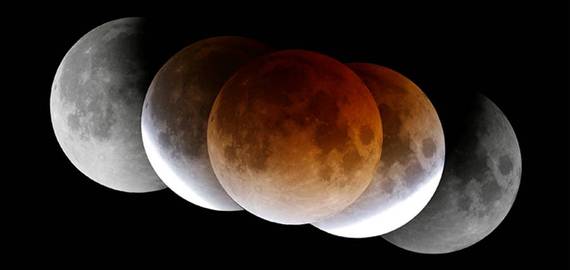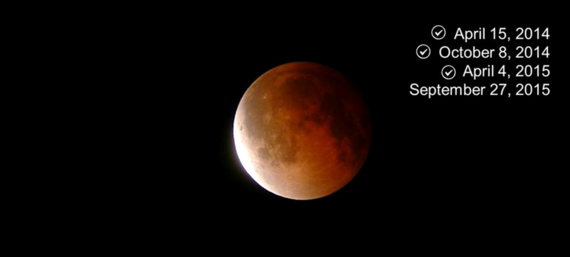Coincidences, coincidences, coincidences. It's all coming together on Sunday for THE astronomical event of the year.
On Sunday September 27 sky watchers in North and South America, Europe and Africa will be treated to a total lunar eclipse. No big deal, right? After all, we had two lunar eclipses in 2014 and one earlier this year. It's true, this will be the fourth total lunar eclipse in less than 18 months. These back, to back, to back, to back eclipses are referred to as a Tetrad and the eclipse on Sunday will complete the series.
But wait, there's more: it will also occur during a Supermoon (the closest full moon of the year) and a Harvest Moon (the full moon closest to the fall equinox). The media loves coincidences like this, and social media might just explode. Some readers may interpret these events as signs from above, new doomsday prophets may portend, history buffs may delve into old records looking for the last time this occurred. If it gets people outside to look at the Moon, I'm all for it. Even without a doomsday, a lunar eclipse will not disappoint.
For me, there are three exciting parts about a lunar eclipse
- The anticipation. The Sun, Earth, and Moon rarely line up and getting ready for the occasion is half the fun. When will it happen? Where should I view? Who should I view with? It's fun planning an eclipse party.
- The point of first contact. When you see the shadow of the Earth first show itself upon the lunar surface, it gives you chills. The alignment begins exactly as the astronomers predicted, down to the exact second, and you're seeing it with the naked eye.
- Totality. When the Moon is completely in the Earth's shadow it can turn eerie shades of gray, orange, pink, and red. You can watch the colors constantly morph as totality continues. What colors will show? Only the shadow knows.
Okay, here's the plan
Call a few friends. Get outside Sunday night. Bring lawn chairs, blankets, picnics, and drinks. Face east and southeast. No telescope or binoculars needed. The eclipse will be visible from everywhere in the United States at the same time, so note that I'm using Eastern Daylight Time below and adjust accordingly.
9:07 PM EDT - The partial eclipse begins (my Exciting Part #2 above)
10:11-11:23 PM EDT - Total eclipse time (#3 above)
12:27 AM EDT - The visible part of the eclipse ends and the Moon seems to return to its normal full self (see #1 above)
Viewers in the Eastern U.S. will see the entire thing. For folks out west, the Sun may not have set when the eclipse begins, and the Moon may rise in partial eclipse. Don't worry, you'll still get to see all of the total eclipse.
One clarification
Many websites claim that the eclipse will occur on September 28. That is true for those in the Eastern Hemisphere (Europe and Africa). For the America's and the Western Hemisphere it will mainly occur on the night of Sunday September 27. So unlike the last three eclipses that were visible before dawn, the final one in the Tetrad will be best seen in the evening.
If you miss this lunar eclipse, the next one isn't until January 31, 2018. That's way too long to build up your anticipation, so this Sunday be sure to keep looking up.


